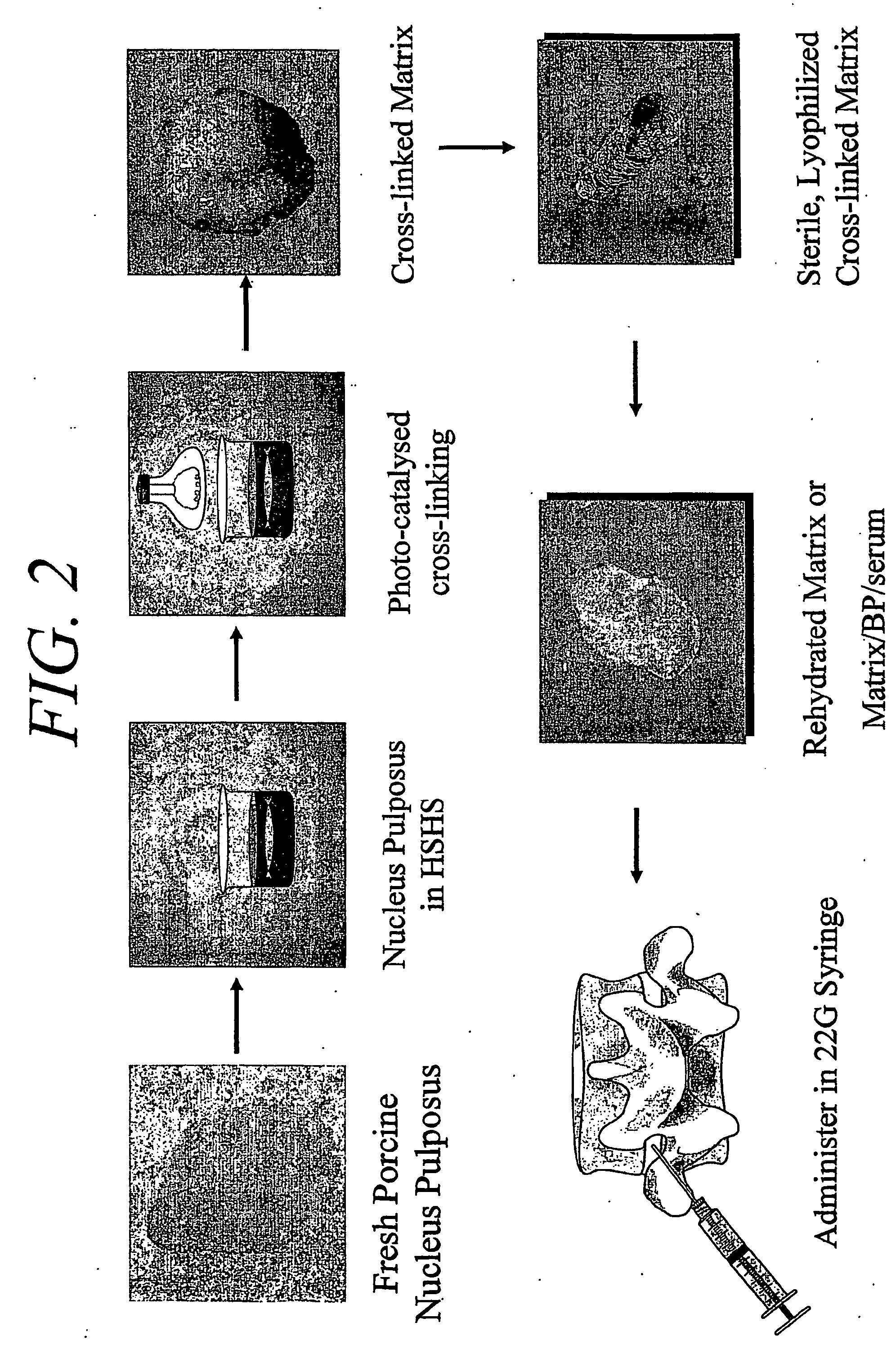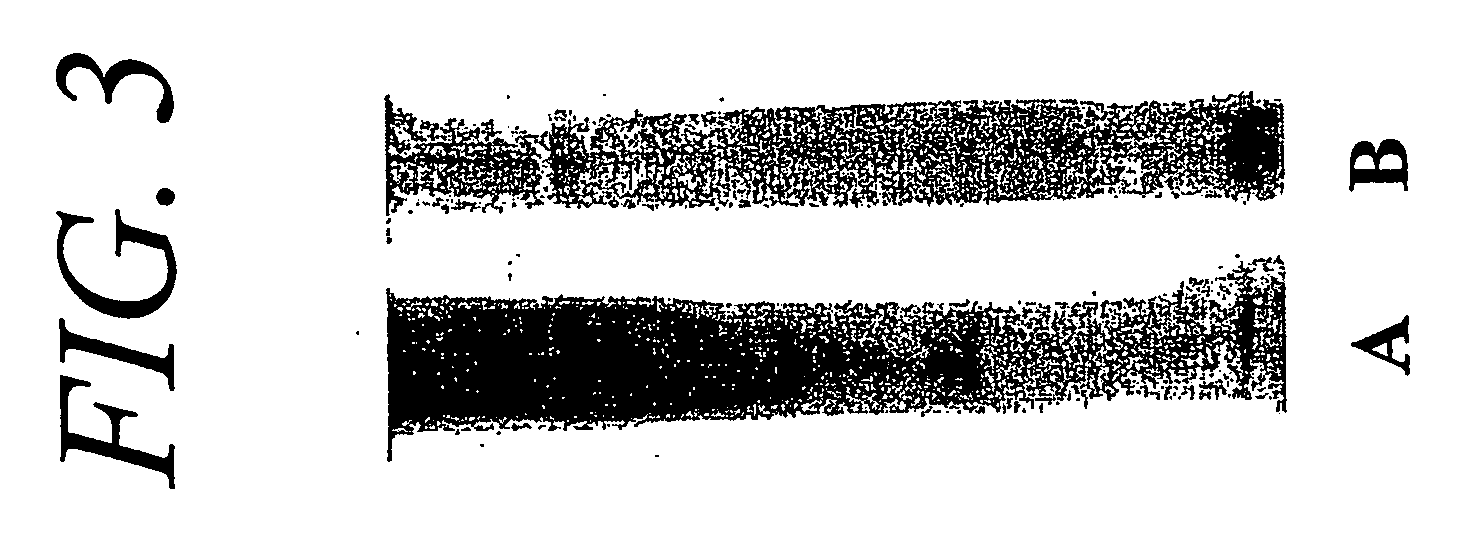Hydrogel compositions comprising nucleus pulposus tissue
a technology of nucleus pulposus and composition, applied in the field of hydrogel composition, can solve the problems of pain, weakness, concomitant loss of disc water content, etc., and achieve the effect of superior handling characteristics of implantation
- Summary
- Abstract
- Description
- Claims
- Application Information
AI Technical Summary
Benefits of technology
Problems solved by technology
Method used
Image
Examples
example 1
5.1 Example 1
Preparation of a Cross-Linked, Fluid Matrix Suitable for Treatment of Degenerative Disc Disease
[0093] A three-dimensional fluid matrix of cross-linked nucleus pulposus tissue in accordance with an embodiment of the present invention may be prepared from donor vertebrates. Although porcine donors were used in a particularly preferred embodiment, nucleus pulposus tissues from other vertebrates may also be used, although mammalian vertebrates are preferred (e.g., human, porcine, bovine, ovine, etc.).
[0094] Although nucleus pulposus tissues may be harvested by a variety of methods from many vertebral donors, in a preferred embodiment nucleus pulposus tissues were dissected aseptically from spinal intervertebral discs of pigs. In a sterile environment (i.e., a laminar flow hood), the annulus fibrosus of porcine donors was sliced radially and the vertebral end plates separated to expose the nucleus pulposus. The latter material was curetted out of the central portion of the...
example 2
5.2 Example 2
Testing of Fluid Matrix to Evaluate Protein Modification Induced by the Cross-Linking Process
[0101] One half gram of the matrix material obtained prior to the lyophilization step of Example 1 was placed in 15 ml of a solution of 4 M guanidine hydrochloride and agitated on a shaker for 24 hours to solubilize proteoglycans. After centrifugation, the supernatant was discarded and the pellet washed in distilled water 3 times for 5 minutes each. The pelleted matrix material was then removed and blot-dried on filter paper.
[0102] One hundred mg of the blot-dried matrix was placed in a 1.5 ml microcentrifuge tube with 1000 μl of 1% sodium dodecyl sulfate (SDS) containing 5% β-mercaptoethanol (BME). The matrix in SDS / BME was boiled for one hour to extract proteins (e.g., collagens). Samples were then centrifuged at 12000 rpm for 1 hour and aliquots of the supernatant were subjected to electrophoresis in gradient polyacrylamide gels.
[0103] Gels were stained with Coomassie blue...
example 3
5.3 Example 3
Matrix Histology to Evaluate Cellular Debris and Residual Membranous Material
[0104] Cross-linked matrix material obtained prior to the lyophilization step of Example 1 was placed in 4% paraformaldehyde for tissue fixation. Standard histology techniques of embedding, sectioning, and staining of sections with hematoxylin & eosin dyes were performed. Visualization of cross-linked matrix in H & E-stained sections demonstrated that the matrix preparation process facilitates destruction of cellular membranes and intracellular elements, with minimal membrane material remaining as compared to fresh porcine nucleus pulposus material as well as non-crosslinked tissue decellularized by HSHS treatment, freeze-thaw cycles, and HSHS treatment plus freeze-thaw cycles. These data are illustrated in FIG. 4.
PUM
| Property | Measurement | Unit |
|---|---|---|
| molecular weight | aaaaa | aaaaa |
| concentration | aaaaa | aaaaa |
| temperature | aaaaa | aaaaa |
Abstract
Description
Claims
Application Information
 Login to View More
Login to View More - R&D
- Intellectual Property
- Life Sciences
- Materials
- Tech Scout
- Unparalleled Data Quality
- Higher Quality Content
- 60% Fewer Hallucinations
Browse by: Latest US Patents, China's latest patents, Technical Efficacy Thesaurus, Application Domain, Technology Topic, Popular Technical Reports.
© 2025 PatSnap. All rights reserved.Legal|Privacy policy|Modern Slavery Act Transparency Statement|Sitemap|About US| Contact US: help@patsnap.com



